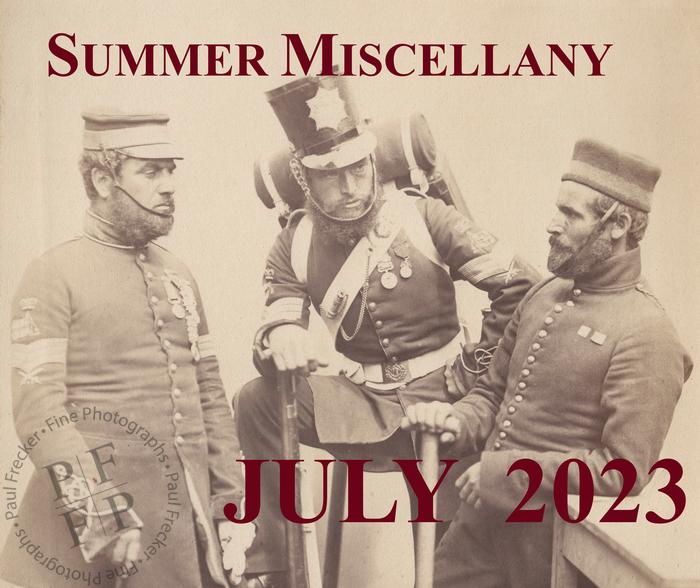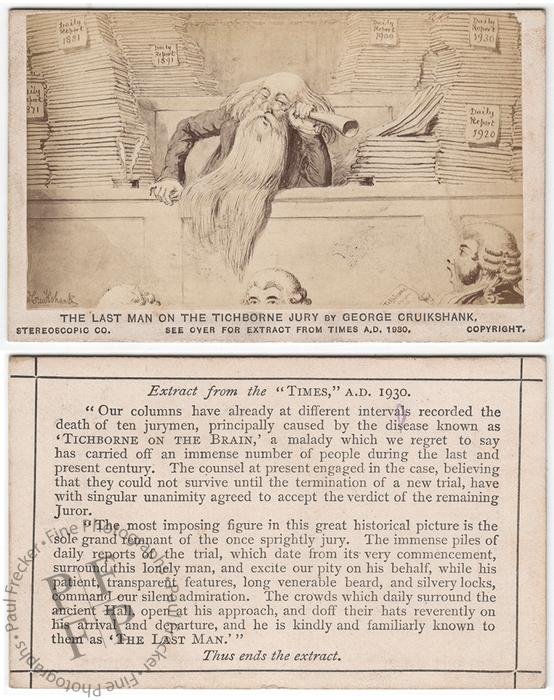
‘The Last Man on the Tichborne Jury,’ 1871
The London Stereoscopic and Photographic Company
A carte de visite showing a cartoon by George Cruikshank satirising the 1871 trial of the Tichborne Claimant and the length of time — 102 days — for which it ran. The joke continues on the back of the mount, which is a spoof extract supposedly from The Times in 1930, written as if the trial were still ongoing some 60 years later.
Produced by the London Stereoscopic Company from a cartoon by George Cruikshank.
Entered at Stationers' Hall [an essential part of the copyright process] on 1 December 1871.
Condition: the print is missing the tip of its upper right hand corner but is otherwise in excellent condition, with good tonal range. The mount is clean, firm and solid.
Dimensions: the dimensions of a standard carte de visite are approximately 4.1" by 2.5" (10.5 cm by 6.3 cm).
code: cat001
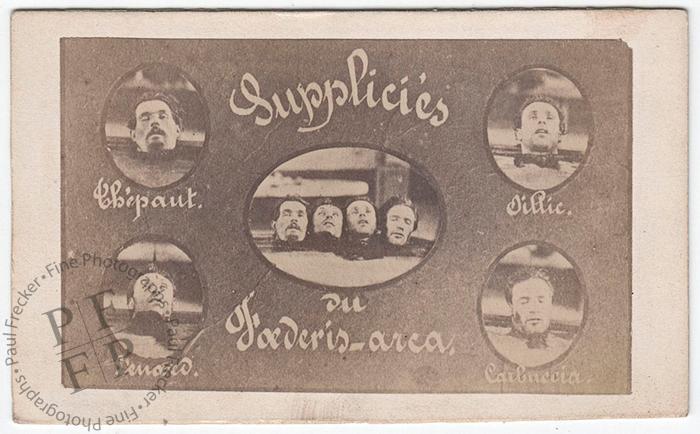
Guillotined heads of four mutineers, 1864
Anonymous
A carte de visite showing the heads of the four mutineers who were executed for the part they played in the mutiny aboard the French merchant ship Fœderis Arca [English: Ark of the Covenant] in 1864. The men had murdered the captain, the second-in-command and the cook during the mutiny.
Reports of the exact date vary but sometime towards the end of June or the beginning of July in the summer of 1864, a mutiny broke out in the Atlantic Ocean aboard the Fœderis Arca, a three-masted vessel freighted with liquors and bound for Vera Cruz. According to an account in the Wellington Independent (29 April 1866), the crew later complained that ‘the ship, being undermanned, the hands had more work to do than was expected of them; they were stinted in their food and what little they had was very bad quality.’ A refusal to obey an order soon escalated to violence and the second, M. Aubert, was stabbed to death and his body thrown overboard, soon followed by the cook and the very much still alive captain, M. Richebourg. According to the Times (13 July 1865): ‘notwithstanding his entreaties and expostulations, he also was thrown overboard and perished. A scene of frightful intoxication then took place, the crew making free use of the absinthe, vermouth, &c, found in the ship’s stores.’
After scuttling the ship, the crew departed the scene in two canoes. Amongst them was an eleven-year-old cabin boy, who was on his first sea voyage. Fearing that he might later denounce them, the sailors threw him into the sea and used their oars to prevent him climbing back into the boats. Soon after, they were lucky enough to be rescued by a Danish brig and taken to one of the Cape Verde islands.
‘The depositions made to the authorities of Brest, drawn up in concert by the conspirators, were to the effect that Captain Richebourg had discovered a leak in his ship, that after having worked the pumps without effect, he had ordered the crew in the boats, himself remaining on board with M. Aubert, the cabin-boy, and the cook; and that the vessel soon after went down with all who remained.’ This account of the ship’s loss was initially believed. However, M. Aubert’s brother noticed inconsistencies in the testimony of the youngest sailor, Chicot, and demanded an investigation. The truth emerged when Chicot, seized with remorse, confessed all to his mother. Warrants were issued and the other men were brought back from the various corners of the world to which they had fled. Tried before a maritime court, four of the crew were sentenced to death and the other four acquitted.
The man whose head appears bottom right on this carte was Carbuccia, the ringleader of the mutiny according to some reports.
Photographer unidentified.
Condition: the print presents the usually graininess one associates with a pirated image but it has reasonably good tonal range. The mount is clean, firm and solid. The inked notes of a much earlier (19th century) collector appear verso.
Dimensions: the dimensions of a standard carte de visite are approximately 4.1" by 2.5" (10.5 cm by 6.3 cm).
code: cat002
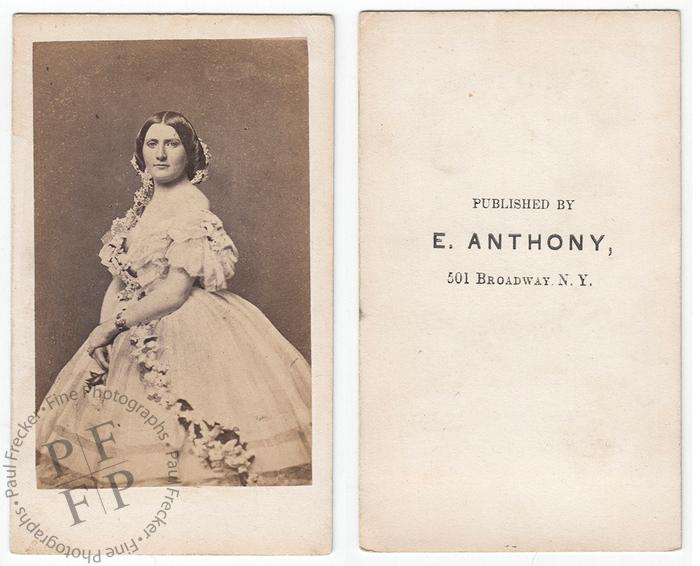
Harriet Lane, c. 1860
Mathew Brady of New York
A carte de visite portrait of Harriet Lane Johnston (1830-1903), First Lady and mistress of the White House 1857-1861. Unique among First Ladies, Harriet Lane acted as hostess for the only President who never married, James Buchanan, her favourite uncle and her guardian after she was orphaned at the age of eleven.
Lane came from a family of prosperous merchants in the rich farming country of Franklin County, Pennsylvania. After the death of her parents, her uncle supervised her education, completed by two years at the Visitation Convent in Georgetown. By this time, ‘Uncle Buck’ was Secretary of State and he introduced her to fashionable circles. In 1854 she joined him in London, where he was minister to the Court of St James, and Queen Victoria gave ‘dear Miss Lane’ the rank of ambassador's wife.
After the sadness of the Pierce administration, ‘Hal’ Lane charmed social gatherings with her captivating mixture of spontaneity and poise. She filled the White House with gaiety and flowers, and guided its social life with enthusiasm and discretion, winning national popularity.
The following is an extract from Belle of the Fifties, the memoirs of Mrs Clay of Alabama covering political and social life in Washington and the South 1853-1866:
‘Miss Lane's entrance into life at the American capital, at a trying time, served to keep the surface of society in Washington serene and smiling, though the fires of a volcano raged in the under-political world, and the vibrations of Congressional strife spread to the furthermost ends of the country the knowledge that the Government was tottering. The young Lady of the White House came to her new honours with the prestige of Queen Victoria's favour. In her conquest of statesmen, and, it was added, even in feature, she was said to resemble the Queen in her younger days. Miss Lane was a little above the medium height, and both in colour and physique was of an English rather than an American type […] In figure, Miss Lane was full; her complexion was clear and brilliant. In her cheeks there was always a rich, pretty colour, and her hair, a bright chestnut, had a glow approaching gold upon it. She had a columnar, full neck, upon which her head was set superbly. I thought her not beautiful so much as handsome and healthful and good to look upon. I told her once she was like a poet's ideal of an English dairymaid, who fed upon blush roses and the milk of her charges; but a lifting of the head and a heightening of the pretty colour in her cheeks told me my bucolic simile had not pleased her. […] Through her efforts she convinced people to donate art treasures to the Smithsonian, which eventually led to the creation of the Museum of Fine Arts. She herself had acquired a sizable art collection, largely of European works, which she bequeathed to the government. Accepted after her death in 1903, it inspired an official of the Smithsonian Institution to call her the "First Lady of the National Collection of Fine Arts." In addition, she had dedicated a generous sum to endow a home for invalid children at the Johns Hopkins Hospital in Baltimore. It became an outstanding paediatric facility, and its national reputation is a fitting memorial to the young lady who presided at the White House with such dignity and charm.’
Lane eventually married Baltimore banker Henry Elliott Johnston at the age of 36.
Photographed by Matthew Brady and published by E. Anthony.
Condition: the print presents some small imperfections in the area of the background but is otherwise in very fine condition, with good tonal range. The mount presents a small amount of corner wear and some yellowing verso at its edges but is otherwise in excellent condition.
Dimensions: the dimensions of a standard carte de visite are approximately 4.1" by 2.5" (10.5 cm by 6.3 cm).
code: cat003
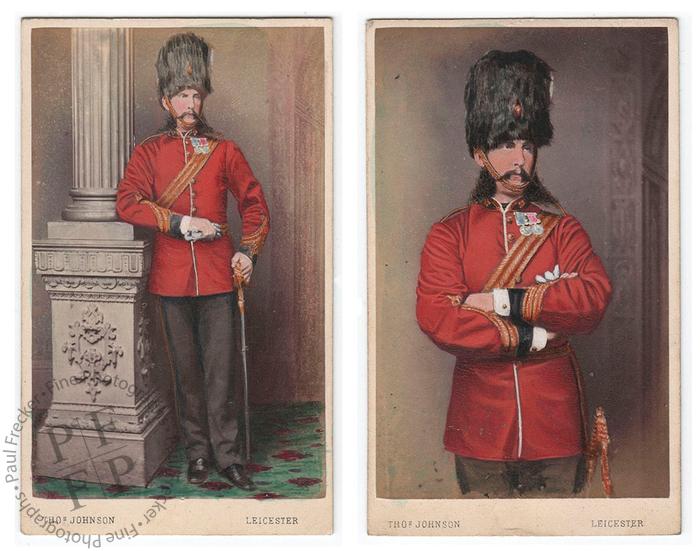
A soldier, c. 1875
Thomas Johnson of Leicester
Two hand-coloured carte de visite portraits of an unidentified British soldier wearing a bearskin, with medals up. The hand-colouring has been executed to a particularly high standard and is still fresh and vivid.
Photographed by Thomas Johnson of Leicester.
Condition: both prints present some small imperfections and some fine spotting in the area of the background but the hand-colouring is in excellent condition. The mounts are clean and firm, with crisp edges and sharp corners.
Dimensions: the dimensions of a standard carte de visite are approximately 4.1" by 2.5" (10.5 cm by 6.3 cm).
code: cat004
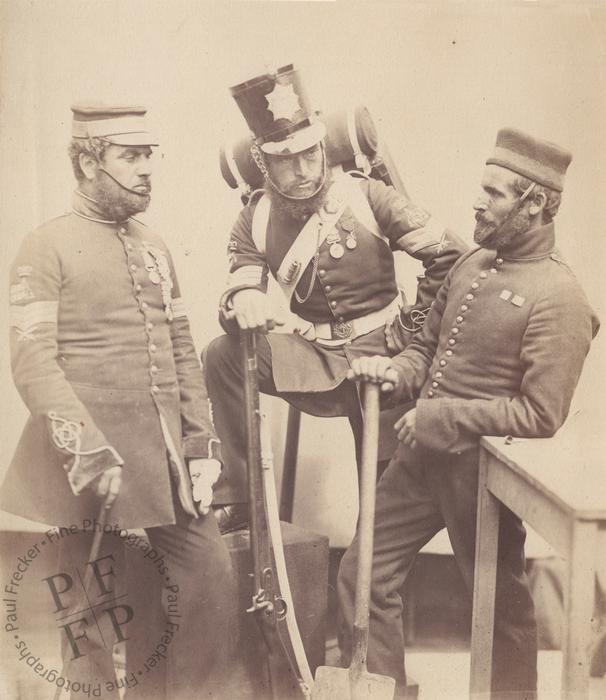
Veterans of the Crimean War, 1856
Joseph Cundall and Robert Howlett
A lightly albumenised print showing three veterans of the Crimean War. The portrait is titled 'Royal Sappers and Miners' in the lower margin.
The three soldiers seen here are the Colour Sergeants J. Stanton, Kester Knight and W. Bruce, photographed when they were 'freshly returned from Turkey.'
Photographed by Joseph Cundall and Robert Howlett as part of a series of portraits undertaken at the behest of Queen Victoria.
According to the website of the Royal Collection Trust: ‘Throughout the war Queen Victoria had taken an active interest in the welfare of the troops and on their return from the Crimea she met a number of the veterans at Buckingham Palace, Chatham Military Hospital and Aldershot Garrison. Following these meetings she commissioned a series of photographs of the veterans from the photographers Joseph Cundall and Robert Howlett.’
Condition: please see scans. The print presents a couple of small imperfections in the area of the background but is otherwise in excellent condition. It is mounted on a large piece of firm white card; this is clean but has sustained a small tear low down on its left-hand edge and its lower right-corner is a little soft and worn.
Dimensions: the print measures 8.6” by 7.4” (21.8 cm by 18.9 cm); the mount measures 14.3” by 12” (36.3 cm by 30.5 cm).
code: cat005
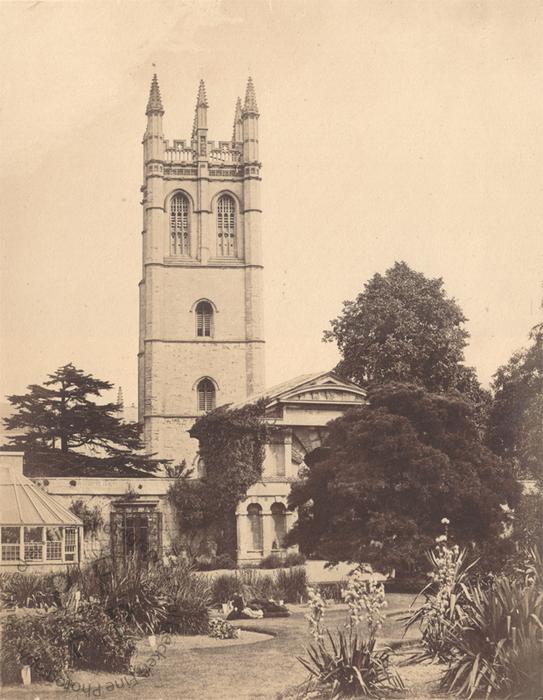
Magdalen College Tower, 1856
Philip Henry Delamotte
An albumen print view of Magdalen College Tower at Oxford, showing the tower and garden of the college, with a young man lying on the grass, his head resting on his hand and his jauntily placed top hat shading his eyes.
A pencilled inscription recto in the lower margin in a period hand reads: ‘Magdalen Tower Oxford.’ A printed label verso gives the full title: ‘Magdalene [sic] College Tower, from the River Cherwell, Oxford.’ This exactly matches in every particular – including the spelling mistake – the title of a work listed in Roger Taylor’s Photographs Exhibited in Britain 1839-1865: A Compendium of Photographers and Their Works (National Gallery of Canada Library and Archives, Occasional Paper No 5, published 2002). It was exhibited by Philip Henry Delamotte at the London Photographic Society Exhibition of 1857, held at the beginning of that year at the Gallery of the Society of Water Colour Painters, 5 Pall Mall East, London. Delamotte exhibited 21 other works in the exhibition, the majority of them views of Oxford and its colleges. This one was numbered 289 in the exhibition catalogue.
The same photographs had been exhibited the previous month (December 1856) at the Art Manufacture Association. One reviewer claimed that there was some ‘unavoidable distortion’ of the buildings but that ‘[t]hese pictures are, however, remarkable for artistic composition, fine definition, and judicious balance of light and shade’ (Norfolk News, 13 December 1856).
According to an advertisement in The Times (6 March 1857), a set of 40 ‘Photographic Views of Oxford’ by P.H. Delamotte were available as a set in a portfolio for £8 8s or individually priced at 5s each.
The British photographer and illustrator Philip Henry Delamotte (1821-1889) was a Professor of Drawing at King’s College, London. He first gained attention as a photographer for his series of photographs of the dismantling of the Crystal Palace in 1852 and its subsequent reassembly at Sydenham, a project he completed in 1854.
Condition: the print presents a few small imperfections in the area of the sky and a loss of colour at its upper left-hand corner but is otherwise in excellent condition, with very good tonal range. It is mounted on a large sheet of stiff, firm card; this presents a few marks verso, caused by mounting on a secondary support, but is otherwise very clean.
Dimensions: the print measures 8.3” by 6.5” (21.1 cm by 16.4 cm); the mount measures 17.8” by 13.7” (45.3 cm by 35 cm).
code: cat006
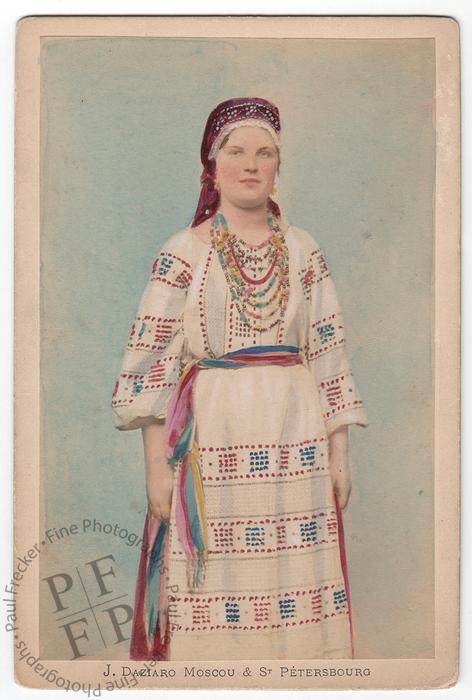
A Russian woman in traditional costume, c. 1870
Anonymous
A beautifully hand-coloured cabinet card of a young Russian woman wearing the traditional costume of her region.
An inked inscription verso in a period hand reads: ‘Wishing you all the best / wishes of the season and a / happy New Year.’
Sold by J. Daziaro of Moscow and St Petersburg.
According to the excellent Luminous-Lint website: ‘Giuseppe Daziaro (1796 or 1806-1865), also known as J. Daziaro and Iosif Khristoforovich Datsiaro, was not a photographer but an Italian with a number of shops: Moscow (1827), St Petersburg with his younger brother Giacomo (1838), Paris (1850) and Warsaw (1855). After the death of Giuseppe in 1865 his brother closed the Paris store and returned to Italy. The Moscow store was taken over by I. L. Gel’dvein and Giuseppe's eldest son, Giuseppe (Joseph) Daziaro / Iosif Iosifovich Datsiaro (1831-1892). Who took the many photographs attributed to these stores is unclear and requires further research.’
Condition: the print presents a few very small imperfections in the area of the background but is otherwise in excellent condition, with beautifully executed hand-colouring. The mount presents some marks and stains verso but is firm and solid.
Dimensions: a standard cabinet card measures approximately 6.5” by 4.3” (16.5 cm by 10.8 cm).
code: cat007
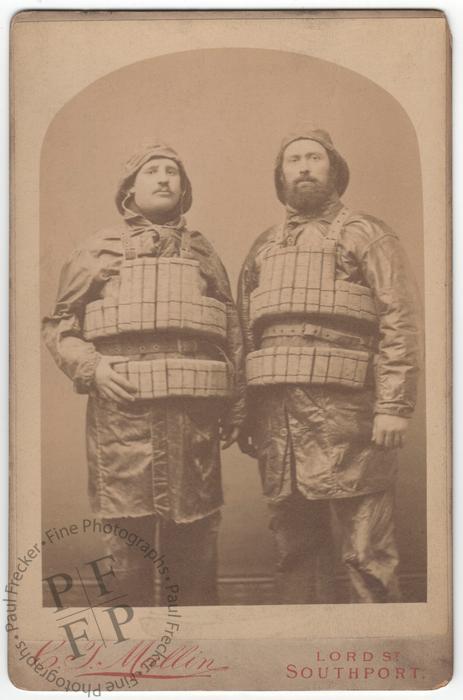
John Jackson and Henry Robinson, 1887
Charles Thomas Mallin of Southport
A cabinet card portrait of John Jackson and Henry Robinson, the only survivors of the 'Eliza Fernley' lifeboat disaster. Their boat went down on 9 December 1886 coming to the aid of the German ship 'Mexico' during a severe storm off the coast of Southport. Of the crew of 16, only Jackson and Robinson survived. Another boat from nearby St Annes went down with all its crew. In all, 28 lifeboatmen lost their lives that night. It was the worst lifeboat disaster in British history.
‘So far as concerns the disaster to the Eliza Fernley, the Southport life-boat, […] its story is told by John Jackson, one of the survivors, who resides in West-street, Southport. He says that the boat was launched successfully and went nicely for a time. A very heavy sea was running, and their troubles soon commenced. […] They were beaten back several time, and shipped an immense quantity of water. It was pitch dark at the time, and the only indication of the distressed barque was the faint glimpse of a lamp which, as the boat got closer, they saw hung from the mizzen top. Jackson was able to discern that the vessel had lost her foremast and mainmast. They were at length within thirty yards of the vessel and could hear no shouting; indeed, the storm rose to such a pitch that it was with difficulty that they could hear their own voices. He was just about letting go the anchor to get the boat alongside, the vessel being then, he should say, twenty yards from the barque, when a tremendous sea caught the boat right amidships and she went over. They expected her to right herself, but she remained bottom upwards. Some of the crew managed at length to crawl out. He and Richard Robinson held firmly on to the rowlocks, and were buffeted about considerably. With some difficulty he got underneath the boat again and spoke, he thought, to Henry Robinson, Thomas Jackson, Timothy Rigby, and Peter Jackson. He called out, “I think she will never right; we have all to be drowned” and heard a voice, probably Henry Robinson’s, say “I think so, too.” […] Another heavy sea came, and Robinson disappeared with it and was never seen again. While underneath, Jackson called out to his brother but could get no answer. […] He drifted with the boat bottom upwards to the beach, and staggered home at three o’clock in the morning’ (Illustrated London News, 18 December 1886).
Photographed by Charles Thomas Mallin of Lord Street, Southport.
Condition: the print presents some small marks and imperfections; the mount is generally on the grubby side and has sustained a small amount of damage at its upper right-hand corner.
Dimensions: the dimensions of a standard cabinet card are 6.5” by 4.3” (16.5 cm by 10.8 cm).
code: cat008
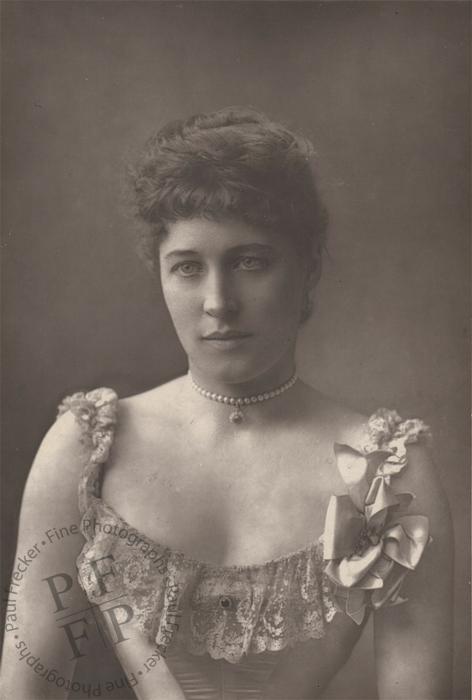
Lillie Langtry, 1890
William Downey
A Woodburytype portrait of the English actress and Lillie Langtry (1853-1929), who for a while became the semi-official mistress of the future Edward VII. When Edward once complained, ‘I’ve spent enough on you to buy a battleship,’ Lillie retorted, ‘And you’ve spent enough in me to float one!’
Born Emilie Charlotte Le Breton, the daughter of a rector, she married Edward Langtry in 1874. She first appeared professionally in London in 1881; her greatest success was as Rosalind in Shakespeare’s As You Like It. Her first husband having died in 1897, she married Sir Hugh de Bathe in 1899. She died in Monaco in 1929 and was buried in the churchyard of St Savour’s in Jersey, the church where her father had been rector.
She was known as ‘the Jersey Lily’ from her birthplace and was considered to be one of the most beautiful women of her day. When she walked into restaurants, people would stand on chairs to get a better look at her.
Photographed by William Downey of London and Newcastle
Published as part of the first series of The Cabinet Portrait Gallery in 1890.
Condition: the print is in very fine condition with excellent tonal range; the page on which it’s mounted a very small amount of wear at its four corners but is otherwise crisp and clean.
Dimension: the print measures 5.5” by 3.7” (14 cm by 9.9 cm); the page measures 9.9” by 7.8” (25.2 cm by 19.9 cm).
code: cat009
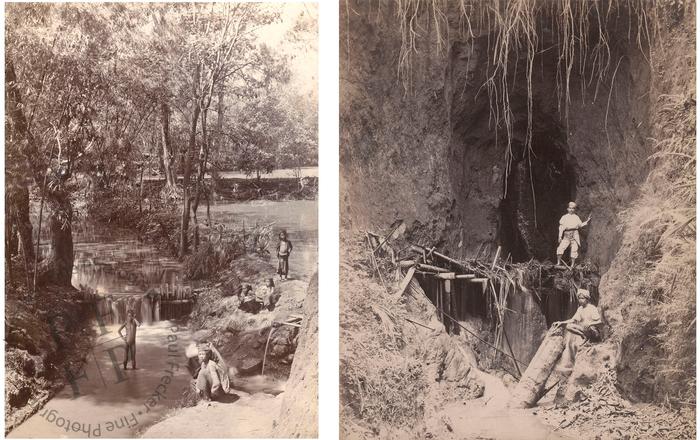
Java, c. 1875
Anonymous
Two albumen prints showing views of Java.
The first shows Javanese children beside the river Sawah, the second shows two young men at the entrance to a large cave.
The two prints are mounted on two album pages which at some point have been taped together verso by strip of bright red tape (the tape is vintage, not modern). The positioning of the caption in the lower margin suggests that the photographs were always mounted as a double page spread.
The caption in the lower margin is in Italian. It reads ‘Presso il Fiume “Sawah” — Isola di Giava’ [At the River Sawah — Island of Java.]
Photographer unidentified.
Condition: the prints are in excellent condition, with very good tonal range. One album page is missing the tips of two corners and the other has sustained a heavy crease at one corner; otherwise both pages are clean and firm.
Dimensions: the prints are the same height but not quite the same width. The one showing the children at the river measures 8.3” by 6” (21.1 cm by 15.1 cm); the one showing the two men at the cave measures 8.3” by 6.8” (21.1 cm by 17.3”). The overall dimensions of the two album pages together are 9.7” by 13.4” (24.6 cm by 34.3 cm).
code: cat010
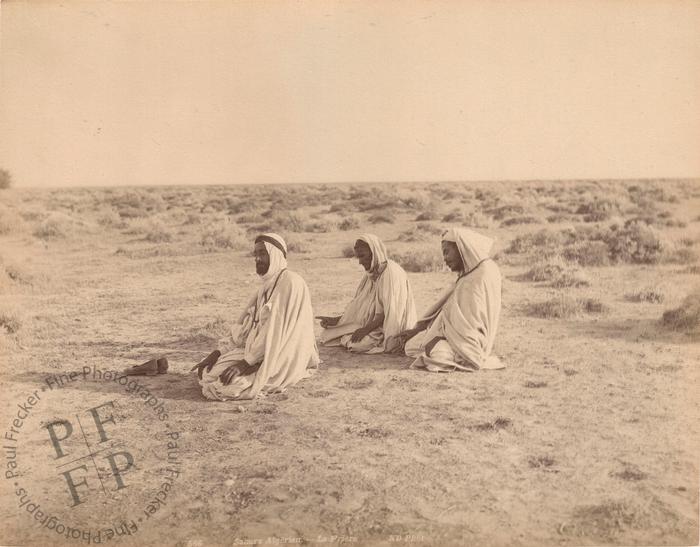
Prayers in the Sahara, c. 1880
'N.D.'
A large format albumen print showing three Arab men at prayer in the Sahara desert.
The photographer is identified by the initials ’N.D.’
Numbered ‘566’ in the negative and titled ‘Sahara Algérien — La Prière’ [English: ‘Algerian Sahara — The Prayer.’]
Condition: apart from a few small imperfections in the area of the sky, the albumen print is in excellent condition. It is mounted on a firm, solid, cream-coloured album page, which presents some corner wear, one small tear running off its upper edge and a pale watermark at its upper left-hand corner. Reverse of the mount is blank.
Dimensions: the print measures 8.3” by 10.7” (21.1 cm by 27.2 cm); the mount measures 9.1” by 12.6” (23.1 cm by 31.9 cm).
code: cat011
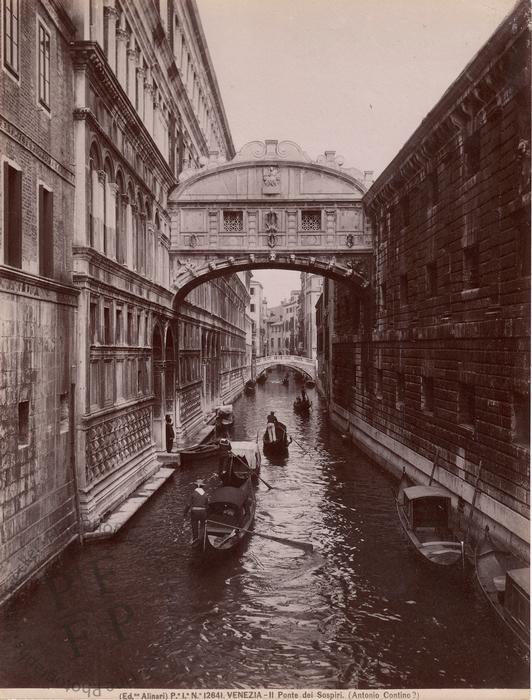
The Bridge of Sighs in Venice, c. 1880
Fratelli Alinari
An unmounted albumen print showing gondoliers passing under the Bridge of Sighs in Venice.
Built of white limestone in 1600 to the designs of Antonio Contino, the bridge passes over the Rio di Palazzo, connecting the New Prison [Prigioni Nuove] to the interrogation rooms in the Doge’s Palace. Prisoners supposedly glimpsed their last view of the city from the bridge, hence its name.
Photographed by Fratelli Alinari of Florence [Firenze].
Founded by Leopoldo Alinari in 1852 — he was joined two years later by his brothers Giuseppe and Romualdo — the studio specialised in topographical views of Italy, particularly its monuments and architecture, though regular portrait photography was also available. The studio is still in existence today; its archives house over 5.5 million photographs.
Signed, numbered ‘12641’ and captioned ‘VENEZIA - Il Ponte dei Sospiri’ in a narrow white border along its lower edge.
Condition: the print is in excellent condition, with very good tonal range.
Dimensions: the print measures 9.9” by 7.5” (25.1 cm by 19.1 cm) including the border at its lower edge.
code: cat012
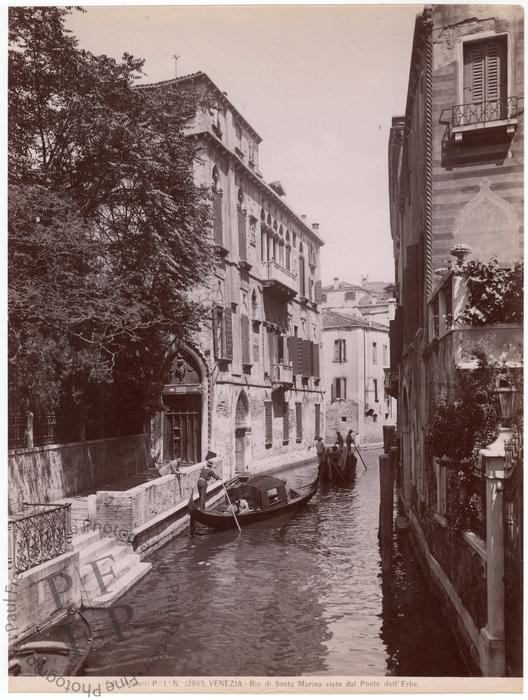
The Rio di Santa Marina in Venice, c. 1880
Fratelli Alinari
An unmounted albumen print showing gondoliers passing along the Rio di Santa Maria in Venice.
Photographed by Fratelli Alinari of Florence [Firenze].
Founded by Leopoldo Alinari in 1852 — he was joined two years later by his brothers Giuseppe and Romualdo — the studio specialised in topographical views of Italy, particularly its monuments and architecture, though regular portrait photography was also available. The studio is still in existence today; its archives house over 5.5 million photographs.
Signed, numbered ‘12865’ and captioned ‘VENEZIA - Rio di Santa Maria vista dal Ponte dell’Erbe’ in a narrow white border along its lower edge.
Condition: the print presents a loss of tone at the tip of its upper right-hand corner but is otherwise in excellent condition, with very good tonal range.
Dimensions: the print measures 9.9” by 7.5” (25.1 cm by 19.1 cm) including the border at its lower edge.
code: cat013
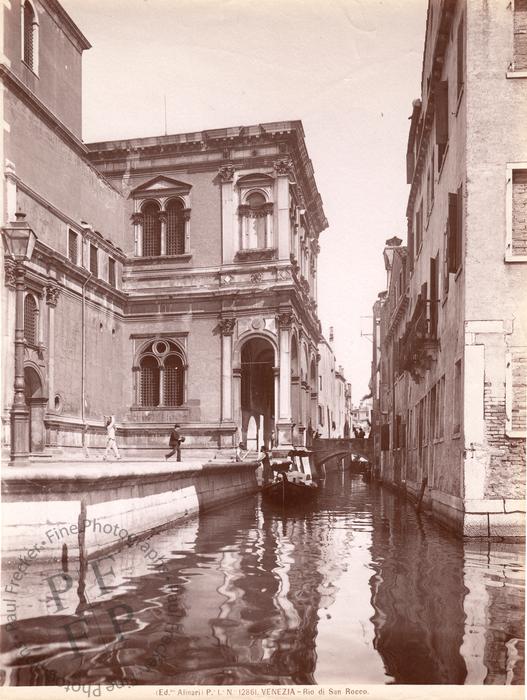
The Rio di San Rocco in Venice, c. 1880
Fratelli Alinari
An unmounted albumen print showing a gondolier in the Rio di San Rocco in Venice.
Photographed by Fratelli Alinari of Florence [Firenze].
Founded by Leopoldo Alinari in 1852 — he was joined two years later by his brothers Giuseppe and Romualdo — the studio specialised in topographical views of Italy, particularly its monuments and architecture, though regular portrait photography was also available. The studio is still in existence today; its archives house over 5.5 million photographs.
Signed, numbered ‘12861’ and captioned ‘VENEZIA - Rio di San Rocco’ in a narrow white border along its lower edge.
Condition: the print is in excellent condition, with very good tonal range.
Dimensions: the print measures 9.9” by 7.5” (25.1 cm by 19.1 cm) including the border at its lower edge.
code: cat014
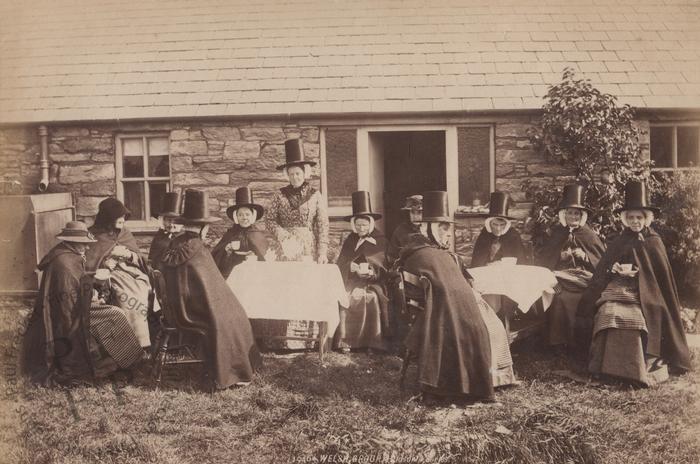
Welsh women, c. 1880
Hudson's Series
An albumen print showing a group of Welsh women drinking tea outside a single storey building. Most of the women are wearing traditional Welsh costume, including the narrow-brimmed high-crowned Welsh hat.
The image may be understood as part of the commercial photographer’s fascination with ‘the exotic other,’ wherever it might be found. The women of the Welsh valleys and their traditional costumes were no less alien to an urban, middle-class audience than the inhabitants of the rain forests of Borneo. Ignoring the harsh realities of agricultural life, the photographer has concentrated instead on tea-drinking, a trope that occurred frequently in depictions of the region’s inhabitants, as if the Welsh somehow had an even greater proclivity for the beverage than their English neighbours.
Photographed by Hudson’s Series, identified in the print along the lower edge.
Condition: the print is in excellent condition, with very good tonal range. It is mounted on a section of cut-down album page, the reverse of which carries a view of a valley in North Wales.
Dimensions: the print measures 5.3” by 7.8” (13.3 cm by 19.7 cm); the mount measures 6.6” by 10.2” (16.9 cm by 26 cm).
code: cat015
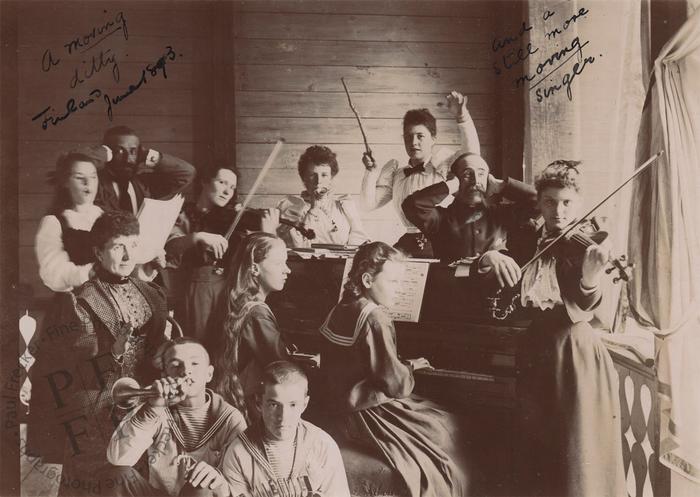
A cacophony in Finland, 1893
Anonymous
An unmounted, glossy silver gelatin print showing as charming staged scene with an even more charming inscription, showing what purports to have been a cacophonous musical experience in Finland one June day in 1893.
Inked inscriptions recto in a period hand read 'A moving ditty / Finland, June 1893' and in the opposite corner 'and a still more moving singer.' Another longer inscription in the same hand on the reverse of the print reads:
'Will no one tell me what she sings!
Perhaps the plaintive numbers flow
For old, unhappy, far-off things
And battles long ago;
Or is it some more humble lay,
Familiar matter of today?
Some natural sorrow, loss or pain
That has been and may be again!'
(Mons. Doriac and Uncle Alick sotto voce)
'Whate’er the theme, the maiden sang
As if her song could have no ending.'
Photographer unidentified.
Condition: please see scans. The print presents a few minor imperfections and very slightly bumped corners but is otherwise in excellent condition, with very good tonal range.
Dimensions: the print measures 4.7” by 6.6” (12 cm by 16.9cm).
code: cat016
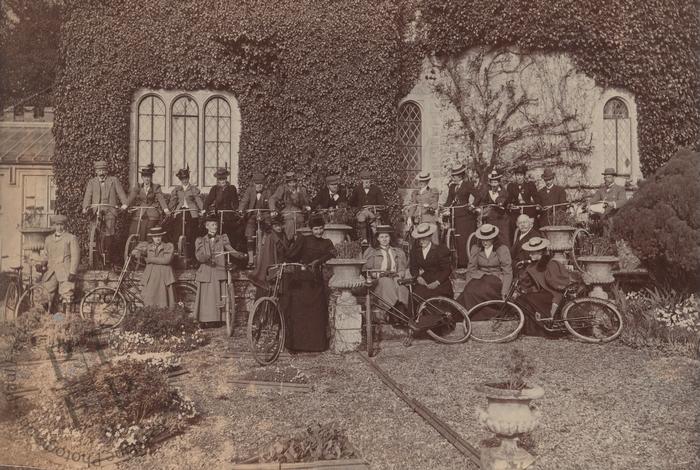
Cyclists at Wolfeton House, c. 1895
Anonymous
An unmounted, glossy silver print showing a large number of cyclists, mostly women, arranged in front of an ivy-clad wall. The women’s clothes date the photograph to the mid to late 1890s. A pencilled inscription verso in a period hand reads: ‘Bicycle meet at Wolfeton House.’
Wolfeton House is a Tudor-Elizabethan manor house in Dorset.
Photographer unidentified.
Condition: the print has sustained diagonal creases at its upper left and lower right corners but is otherwise in good condition, with excellent tonal range.
Dimensions: the print measures 5.3 by 7.8” (13.4 cm by 19.7 cm).
code: cat017
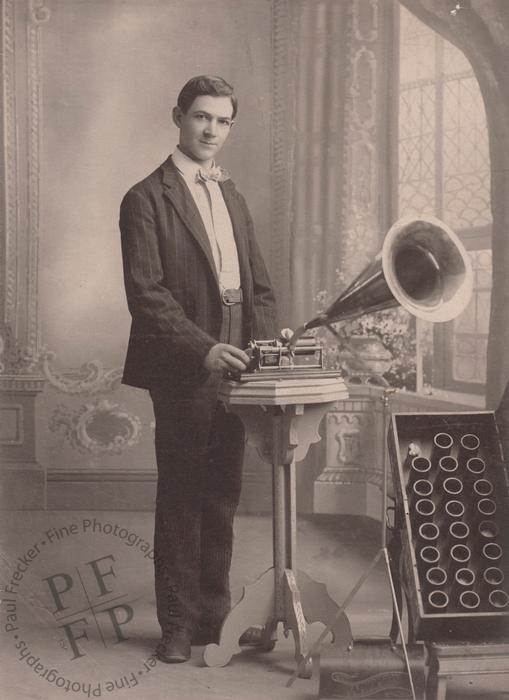
H.L. Thomas with his Graphophone, c. 1897
Saunders Art Gallery of Woodward, Oklahoma
A gelatin silver print portrait of a young man with a Graphophone. This appears to be the Columbia Eagle model, which first appeared in 1897, when it cost $12 with a lid or $10 without. Its oak lid, painted with the company’s name, can be seen on the floor near the lower right-hand corner of the image, besides the box of wax cylinders.
The sitter and the photographer are both named verso in pencil in a modern hand. Presumably these are transcriptions by a collector or dealer of information that once appeared on an album page.
The young man is identified as ‘Mr H. L. Thomas.' This is probably Herbert Lee Thomas, who was born in Missouri on 16 November 1874. When the US census was taken in 1900, he was living in Woodward, Oklahoma, and working as a clerk in his father Jacob’s drugstore. He died, aged 43, in Arkansas on 30 September 1918. According to his obituary in a local paper: ‘A few weeks ago, Lee, as he was known by his friends, volunteered for industrial work and was sent to Little Rock to work in a plant having large government war contracts. Shortly after his arrival he contracted pneumonia and succumbed to the disease in a few days.’ His body was returned to Woodward and buried in Elmwood Cemetery. He was survived by his wife and only son, William McKinley Thomas.
Photographed by the Saunders Art Gallery of Woodward, Oklahoma.
Condition; the print presents a couple of very small abrasions near its upper edge but is otherwise in excellent condition with good tonal range. It has been neatly skimmed off a secondary support, presumably an album page.
Dimensions: the print measures 6.5” by 4.7” (16.4 cm by 11.9 cm).
code: cat018
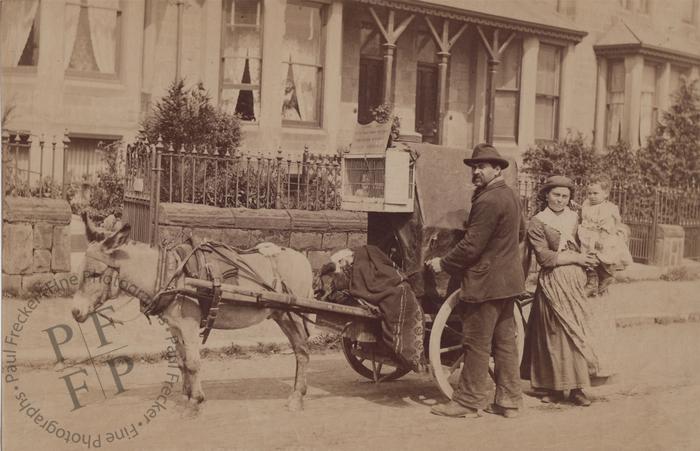
Immigrant family with barrel organ, c. 1900
Anonymous
An unmounted albumen print showing an immigrant family of itinerant musicians with a barrel organ mounted on a cart drawn by a donkey. The man’s clothes suggest he might originally have hailed from Italy or perhaps somewhere in the Balkans. Note the photobomber at the window in the background.
The sign above the birdcage fixed to the side of the barrel organ reads in part ‘Charming Birds / For the small sum of one penny / from this box …’ Although the rest of the text is illegible, street musicians commonly trained caged canaries to 'tell fortunes' by drawing pre-prepared cards from a deck, as an entertainment for children of middle class families.
Photographer unidentified.
Condition: the print is in excellent condition, with very good tonal range.
Dimensions: the print measures 5.2” by 7.9” (13.3 cm by 20.2 cm).
code: cat019
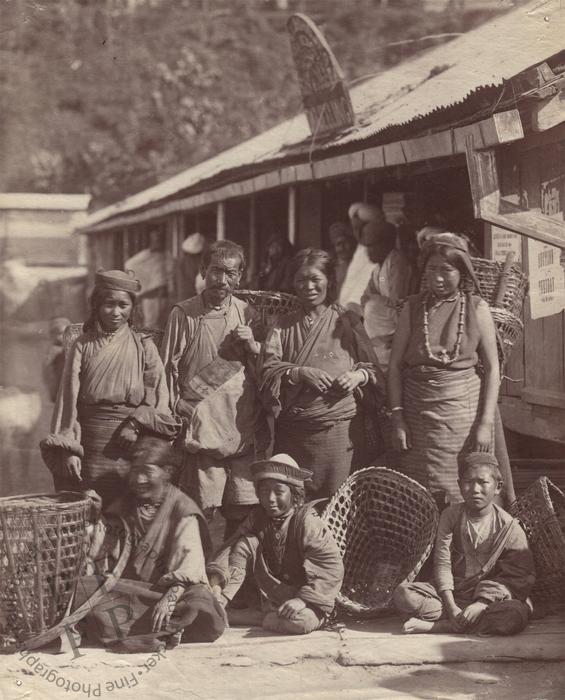
Lepcha people of Sikkim, northeast India, c. 1869
Anonymous
An unmounted albumen print showing a group of Lepcha or Rong people of Sikkim in northeast India.
The Lepcha are the aboriginal inhabitants of present day Sikkim, a landlocked Indian state nestled in the Himalayas between Nepal and Bhutan. Many Lepcha are also found in western and southwestern Bhutan, eastern Nepal, and even the hills of West Bengal. They are also known as the Rong, Rongke or Rongpa. Their origins are obscure but since they speak a Tibeto-Burman language, some anthropologists suggest they originally migrated from Tibet.
Photographer unidentified but possibly taken around 1869 by an anonymous photographer for inclusion in the Frith Series of photographs of the region and its people. Alternatively, the photograph might have been taken by John Doyle of Darjeeling.
Condition: the print presents a few, very small imperfections but is otherwise in excellent condition, with very good tonal range.
Dimensions: the print measures 7.9” by 6.4” (20 cm by 16.3 cm).
code: cat020
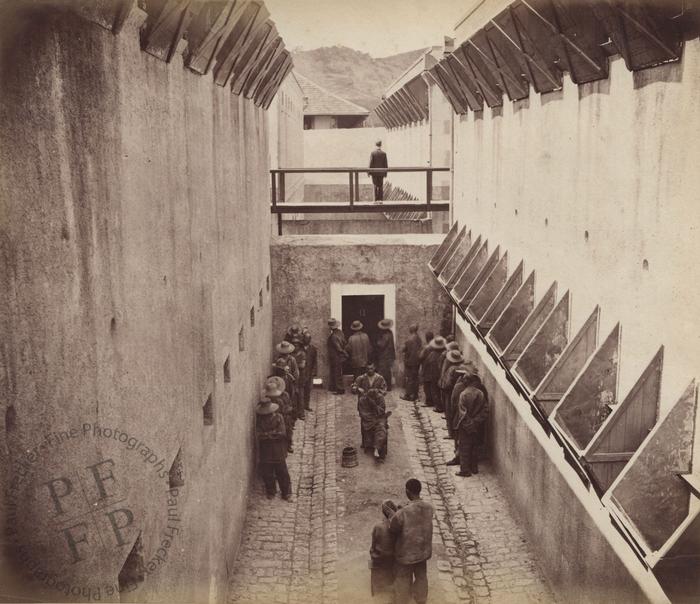
Prison haircuts in New Caledonia, c. 1880
Anonymous
An albumen print showing two prisoners receiving haircuts in the courtyard of a prison in New Caledonia, while more prisoners wait in line against the wall.
A survey of 1888 indicated that on 1 May that year there were 10,428 convicts on the island, including 2329 who had served their sentence and been freed. Those imprisoned included many Communards, convicted for their part in the Paris Commune of 1871, among them Henri de Rochefort and Louise Michel.
The reverse of the album page shows a similarly sized photograph showing a group of some twenty Kanaks in the forest within a vignette (scan available on request).
Photographer unidentified, but possibly by Allan Hughan (1834-1883), a ship’s captain who, after being shipwrecked, established a studio in Noumea in 1871.
Condition: the print is in excellent condition, with very good tonal range. The album page has warped very slightly in its upper and lower margins and presents a small amount of light foxing.
Dimensions: the print measures 7” by 8.1” (17.8 cm by 20.7 cm); it is mounted on an album page measuring 9.4” by 11.5” (23.9 cm by 29.2 cm).
code: cat021
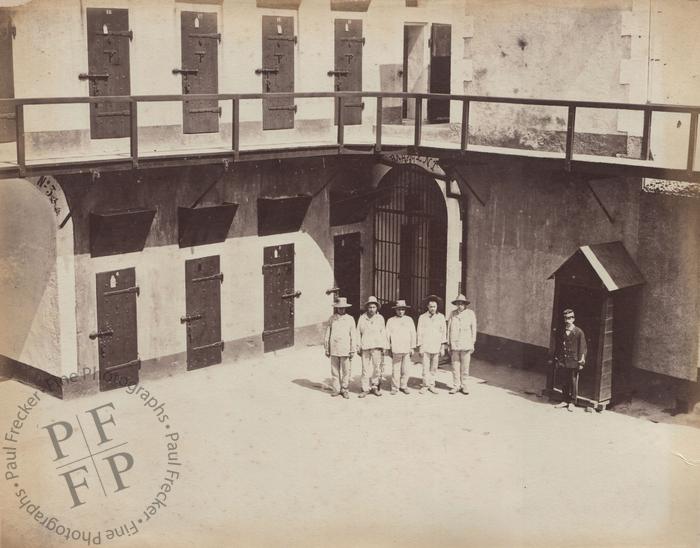
Prisoners in New Caledonia, c. 1880
Anonymous
An albumen print showing five prisoners lined up under the gaze of a guard in the courtyard of a prison in New Caledonia in the southwest Pacific, then a French dependency, now an overseas territory of France. A pencilled inscription in the lower margin reads: ‘Interior Prison, New Caledonia.’
France took formal possession of New Caledonia in 1853. In 1864 it became a penal colony and from then until the end of transportation in 1897 about 22,000 criminals and political prisoners were sent to New Caledonia. The last prison closed in 1923.
The reverse of the album page carries a similarly sized photographed showing a much wider view of another compound, titled ‘Cavalry Barracks, Noumea, N.C.’ in the lower margin (scan available on request).
Photographer unidentified, but possibly by Allan Hughan (1834-1883), who established a studio in Noumea in 1871.
Condition: the print is in excellent condition, with very good tonal range. The album page has warped very slightly in its upper and lower margins and presents a small amount of light foxing.
Dimensions: the print measures 7” by 9” (17.9 cm by 23 cm); the album page on which it is mounted measures 9.4” by 11.4” (23.8 cm by 29.3 cm).
code: cat022
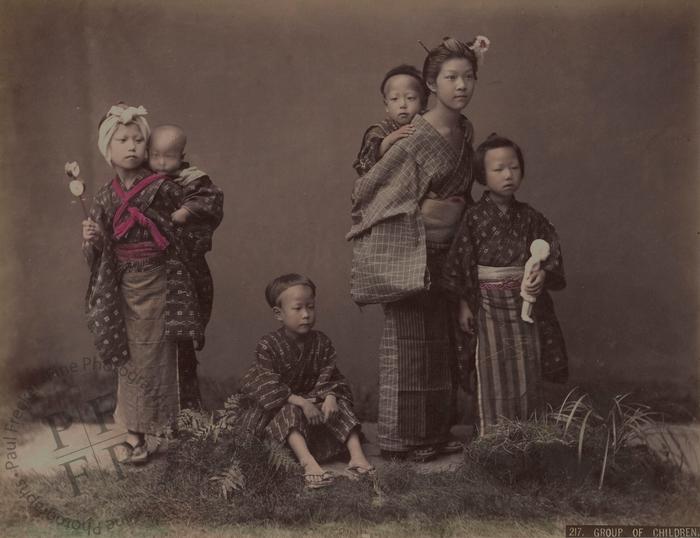
Japanese children, c. 1885
Kusakabe Kimbei
A hand-coloured, unmounted albumen print showing six Japanese children, with the two eldest carrying the two youngest on their backs.
Photographed by Kusakabe Kimbei.
Numbered ‘217’ in the negative and titled ‘Group of Children.’
Prior to opening his own studio, the Japanese photographer Kusakabe Kimbei worked for Felice Beato and Baron von Stillfried as a photographic assistant and as a colourist. In 1881 he established a studio in Yokohama and within ten years his had become one the leading Japanese studios supplying photographs to Western customers. Around 1885 he acquired the negatives of both his former employers (Beato and Von Stillfried), a cause of much confusion for modern-day photo-historians seeking to attribute individual images to particular photographers. Kimbei (his mostly Western customers preferred to use his given name rather than his family name) retired around 1914 and died in 1934.
Condition: the print presents a very slight loss of tone at its upper and lower edges but is otherwise in excellent condition, with rich and satisfying tones.
Dimensions: the print measures 7.9” by 10.1” (20 cm by 25.9 cm).
code: cat023
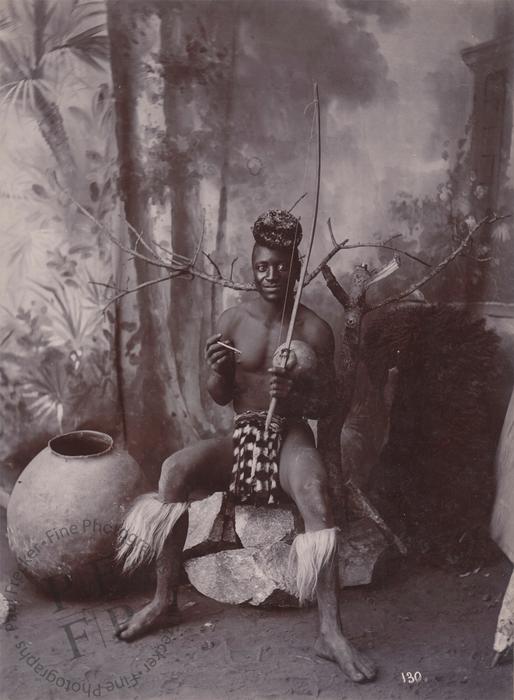
Matabele man, c. 1895
W. Rausch of Bulawayo
A silver gelatin print showing a smiling Matabele man posed with a cigar in one hand and a bow in the other in the photographer’s studio against a painted backdrop. A companion photograph exists, clearly taken on the same occasion, which shows the same man posed with a bottle and a glass The rocks, tree branches and large pottery vessel are presumably supposed to add some verisimilitude to the otherwise jarringly inauthentic scene.
The area known by Europeans in the nineteenth century as Matabeleland now comprises the western provinces of Zimbabwe, with its major city Bulwayo treated as a separate metropolitan province. Its people, then known by Europeans as the Matabele, were the Ndebele, were originally an offshoot of the Nguni people of Natal who migrated north in the 1820s. The British South Africa Company, a mercantile enterprise based in London, established itself in the region in 1890. The Matabele were defeated by the British in the First Matabele War (1893-94) and shortly afterwards the region was divided by the British South Africa Company into two provinces, Matabeleland in the west and Mashonaland (the traditional homeland of the Shona people) in the east. The Matabele Rebellion of 1896-97, also known as the Second Matabele War, failed completely and the Ndebele and Shona people remained subjects of the Rhodes administration. In 1923 Matabeleland became part of self-governing South Rhodesia and part of independent Zimbabwe in 1980.
Photographed by W. Rausch of Bulawayo.
By the middle of the 1890s, the photographer W. Rausch had established a studio in Bulawayo on Abercorn Street opposite the Bank of Africa, where, according to advertisements he placed in local newspapers, ‘All kinds of photographic work undertaken – groups photographed in town or country’ (Bulawayo Sketch, 21 November 1896). He also offered for sale ‘native’ portraits, photographic Christmas cards, and albums depicting the principal streets and buildings of Bulawayo.
Condition: the print is in excellent condition, with very good tonal range.
Dimensions: the print measures 8.1” by 5.9” (20.5 cm by 15 cm) and is mounted on a slightly larger piece of cut-down album page that has been neatly separated from its reverse side by a professional conservator.
code: cat024
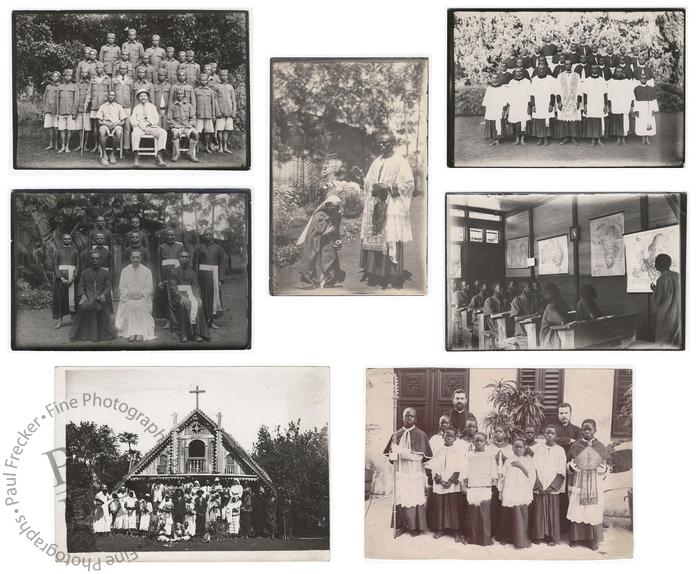
Missionary work in Africa, c. 1900
Anonymous
A small group of seven unmounted photographs mostly showing missionary work in Africa at the turn of the century. European and African clerics feature prominently in most of the images.
One of the prints carries some inscriptions verso in Italian which identify the sitters as ‘chierichetti’ [altar boys] and the location as Zanzibar. The inscription also refers to ‘i rocchetti’ that the boys are wearing. The rochet is a white vestment resembling a surplice, worn over the cassock.
There is nothing to suggest that the other photographs were taken in the same location, but the group were all acquired at the same time from the same source.
Photographer(s) unidentified.
Condition: a few of the prints present some minor corner wear but the photographs are otherwise all in fine to excellent condition.
Dimensions: one print (the one with the elaborately carved wooden church) measures 4.8” by 6.7” (12.2 cm by 17.2 cm) including its white borders. The one showing the altar boys in Zanzibar is a shade smaller. The other five measure 3.9” by 5.8” (9.9 cm by 14.8 cm), including their narrow black borders.
code: cat025
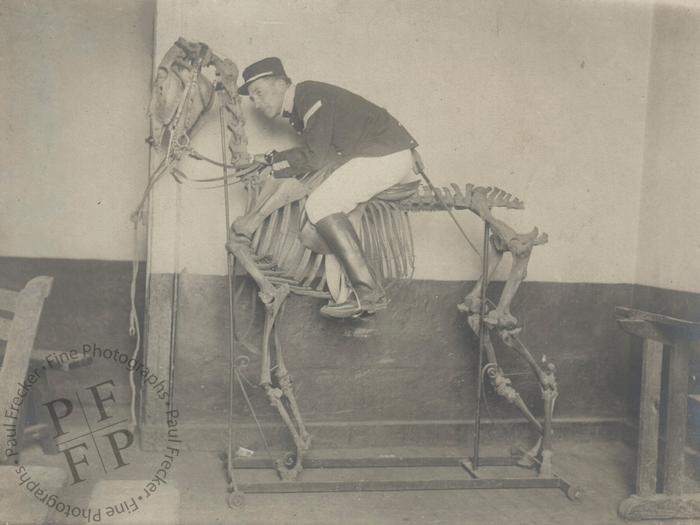
French army officer and horse skeleton, c. 1910
Anonymous
A matt silver print showing a French army officer sitting astride a horse's skeleton as if in the act of riding it.
Photographer and location unidentified but almost certainly French.
Condition: both the print and the mount are in excellent condition. The photograph is mounted on a piece of grey Bristol board which is clean, firm and solid.
Dimensions: the print measures 3.3” by 4.5” (8.5 cm by 11.4 cm); the mount measures 4.9" by 6.05" (12.6 cm by 15.4 cm).
code: cat026

Seven servants, c. 1890
Anonymous
A matt silver print showing a group of Black servants, presumably somewhere in North American. The long whip he is carrying indicates that the man in a top hat is coachman. The other two men appear to be outdoor workers of some kind, while the four women are all maids working inside the house.
Photographer and location unidentified.
Condition: apart from a very few, very small imperfections, the print is in excellent condition. The stock on which it’s mounted is clear, firm and crisp.
Dimension: including a narrow white border, the print measures 5” by 7” (12.7 cm by 17.7 cm).
code: cat027
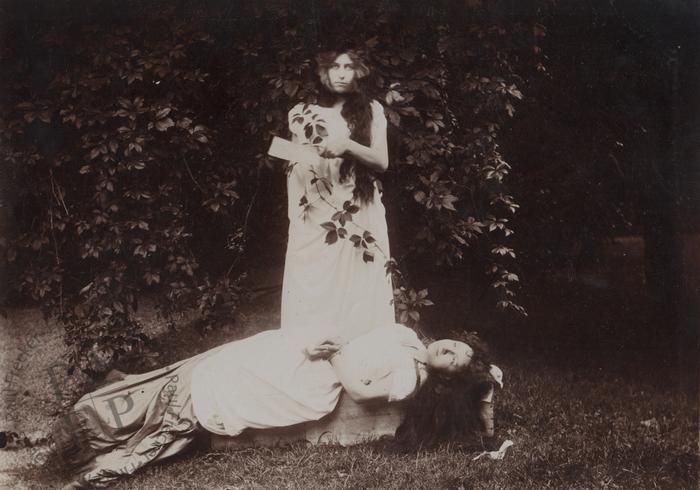
Amateur dramatic sacrifice. c. 1900
Anonymous
A warm-toned, glossy silver print showing a scene staged by two young women, possibly in their own garden.
Photographer and location unidentified.
For further reading see Acting the Part: Photography as Theatre, ed. by Lori Pauli (2006).
Condition: the print, which is unmounted, is in excellent condition, with very good tonal range.
Dimension: the print measures 4.8” by 6.8” (12.1 cm by 17.3 cm).
code: cat028
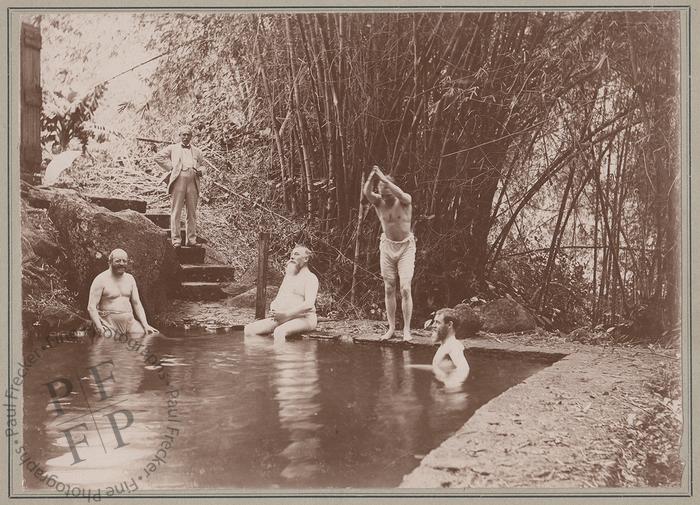
Bathers at a sulphur spring in Guadeloupe, c. 1895
Anonymous
A glossy silver print showing five men at some sulphur baths in Guadeloupe. Four of the men are appropriately dressed for their activity and a fifth, standing on the steps, is wearing a suit.
The archipelago of Guadeloupe is an overseas department of France in the Caribbean.
An inscription in German in the lower margin reads: ‘Bad in ein Schwefelquellen in Guadeloupe’ [Bath in a sulphur spring in Guadeloupe].
Photographer unidentified.
Condition: the print is in excellent condition. The mount of greenish-grey Bristol board presents a small amount of minor corner wear and a few small marks verso but is otherwise clean, firm and solid.
code: cat029
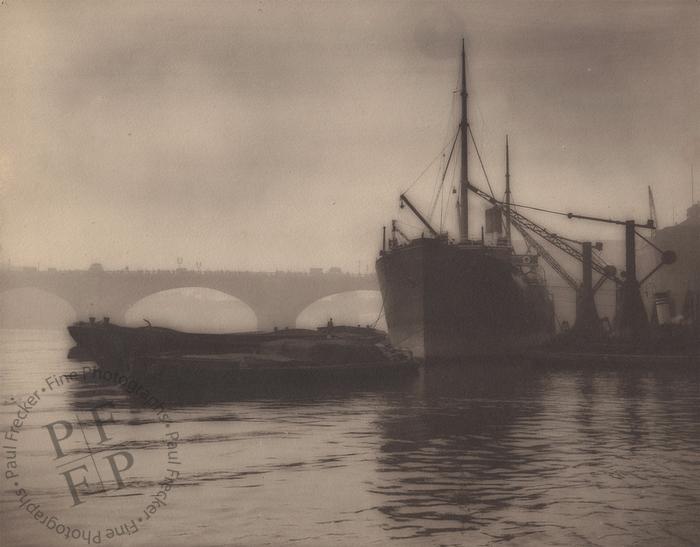
London Bridge, c. 1925
Edward Hillsworth
An unmounted matt silver print showing shipping in the Thames near London Bridge.
Photographed by Edward Hillsworth.
Edward Henry Robert Hillsworth was an amateur photographer and a founding member of the Basingstoke Camera Club. He favoured rural and coastal scenes in Essex, Kent and Sussex though he also made photographic forays as far afield as Cornwall. Most surviving examples of his work are in the Pictorialist style.
Born at Rathmines, a suburb on the southside of Dublin, at the time of the 1901 census he was a ‘Commercial Clerk & Provisions Broker’ living at Wanstead in Essex with his wife Amy (née Best). In 1911 he was a ‘Shorthand Writer & Typist’ at Woodford in Essex. When the Register of 1939 was compiled, he was living in Basingstoke and working as a ‘Clerk in Wholesale Tailoring.’ He died, aged 73, in Basingstoke in 1940.
Condition: the print presents a few small imperfections, including a tiny void at its lower right-hand edge, but is otherwise in excellent condition, with rich and satisfying tones. It is printed on thick, firm, slightly textured stock.
Dimensions: the print measures 8” by 9.8” (22.2 cm by 25 cm).
code: cat030
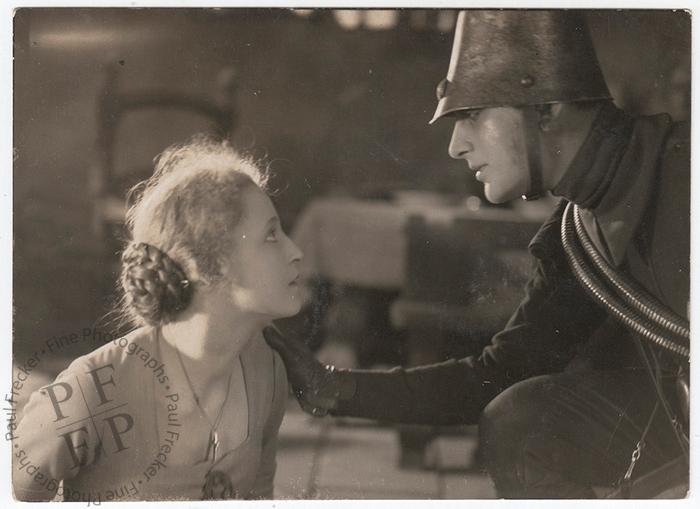
Brigitte Helm, 1927
Anonymous
An unmounted silver gelatin print showing the German actress Brigitte Helm (1906-1996) in one of her early roles.
A pencilled inscription verso in a period hand identifies the film as Au bout du monde. The silent film’s original title in German was Am Rande der Welt, which was translated into English as At the Edge of the World. The film was released in 1927, the same year as Brigitte Helm’s greatest success, Metropolis, directed by Fritz Lang, in which she played both the heroine Maria and the robot.
Photographer unidentified.
Condition: the print presents a few small imperfections but is otherwise in excellent condition. Two deposits of black paper verso suggest it was once mounted on an album page.
Dimensions: the print measures 3.2” by 4.4” (8 cm by 11.2 cm).
code: cat031
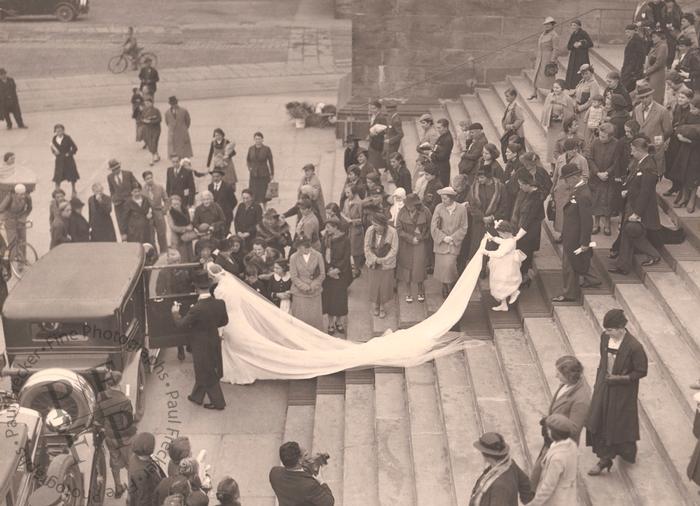
A wedding in Turin, c. 1935
Carlo Gherlone of Turin
A warm toned, matt silver print dating from the late 1930s showing a bride and groom stepping into a car after their wedding service. The location is the steps of La Gran Madre di Dio, a large church in the centre of Turin [Italian: Torino] on the western bank of the River Po, facing the Ponte Vittorio Emanuele I and, on the far side of the river, the Piazza Vittorio Veneto.
Photographed by Carlo Gherlone of Piazza Carlo Felice in Turin [Torino], identified by his wetstamp on the back of the print.
Born in 1891, Carlo Gherlone was a son of the professional photographer Giovanni Gherlone. He died on 19 August 1980.
Condition: the print is in excellent condition, apart from two very small pieces of Sellotape, one at the centre of the left-hand edge and another at the centre of the right-hand edge.
Dimensions: including its narrow white border, the print measures 6.7: by 9” (17 cm by 23 cm).
code: cat032
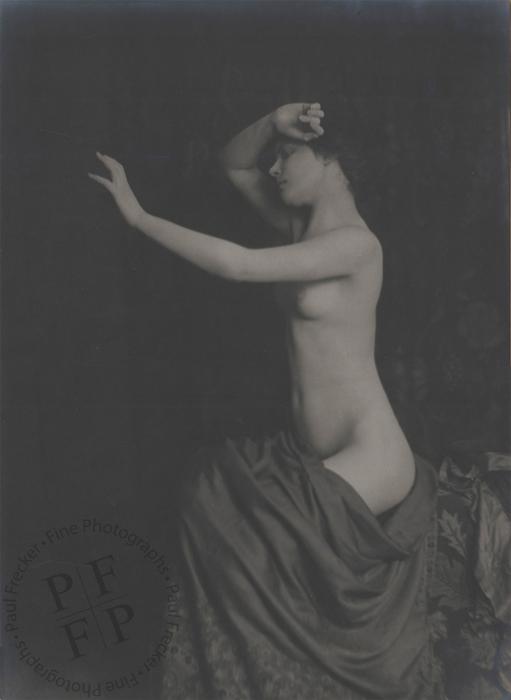
Nude, c. 1930
Bertram Park of London
A vintage matt silver print showing an artistic study of a female nude.
Photographed by Bertram Park.
Bertram Charles Percival Park (1883-1872) was born in Bloomsbury and originally worked in the family firm, which made artists’ materials. In 1910 he was one of the founders of the London Salon of Photography though when the census was taken the following year he made no mention of photography, giving ‘Artist Colour Manufactory’ as his profession. In 1916 he married Yvonne Gregory, with whom he established a studio in Dover Street with funds provided by the Egyptologist Lord Carnarvon. Here he cultivated a clientele drawn from the upper echelons of society. His work also included portraits of British and European royalty, many of which were used on British and Commonwealth stamps and currency, and numerous publicity photographs for theatrical productions. He published a number of photographic books and also wrote on the cultivation of roses, a subject on which he was considered an expert. In later life he lived at Pinner in Middlesex. He died there on 25 December 1972 at the age of 89, leaving an estate valued at £105,853.
Condition: the print is in very fine condition, with good tonal range; the mount presents a very faint smudge near its upper right-hand corner but is otherwise also in excellent condition.
Dimensions: the print measures 9.6” by 7” (24.4 cm by 17.7 cm). It is tipped on to its original card mount; this measures 14.9” by 11.1’ (37.8 cm by 28.2 cm).
code: cat033
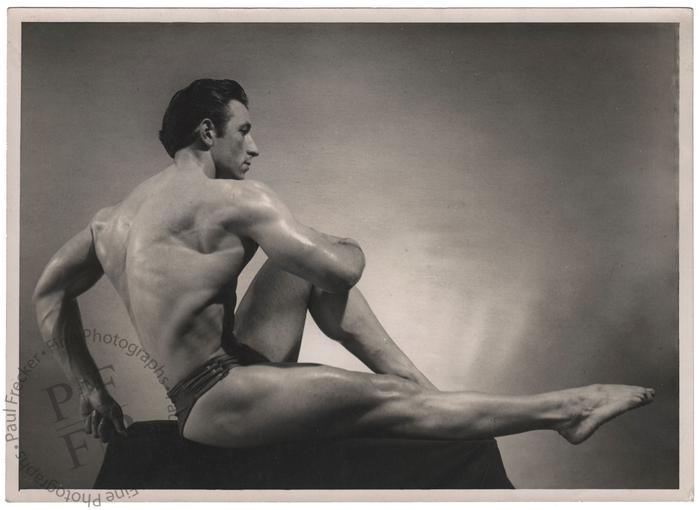
Roger Novaro, 1951
Studio Arax of Paris
A glossy silver gelatin bromide physique photograph showing a named bodybuilder of the 1950s.
A pencilled inscription verso reads: ‘Roger Novaro, 5eme plus bel athlète de Belgique, 1951’ [English: ‘Roger Novaro, Belgium’s 5th handsomest athlete, 1951’].
Another inscription in red ink adds ‘Gand’ [English: ‘Ghent’] after his name, and above his name ‘Plus bel athlète de Flandre’ [English: ‘the most beautiful athlete in Flanders’].
According to the website MuscleMemory, Roger Novaro entered various competitions between 1947 and 1955. In 1952 he was crowned Mr Belgium in the Tall category; the following year he came 2nd in the same category and in 1955 he was 3rd. The website also validates the inscription verso; he did indeed place 5th in 1951.
Photographed by Studio Arax of Paris.
According to Kenneth Krauss (Male Beauty: Postwar Masculinity in Theater, Film, and Physique Magazines, 2014): ‘Gregor Arax, whose studio in Paris had been producing high-quality male nudes since the 1930s, was a Greek who kept his studio at 31 Boulevard Raspail for more than three decades. [He was] primarily known for his meticulous studio pictures.’
Condition: apart from a few small marks in the area of the background, the print is in excellent condition with very good tonal range.
Dimensions: including a narrow white border, the print measures 5” by 6.9” (12.6 cm by 17.6 cm).
code: cat034
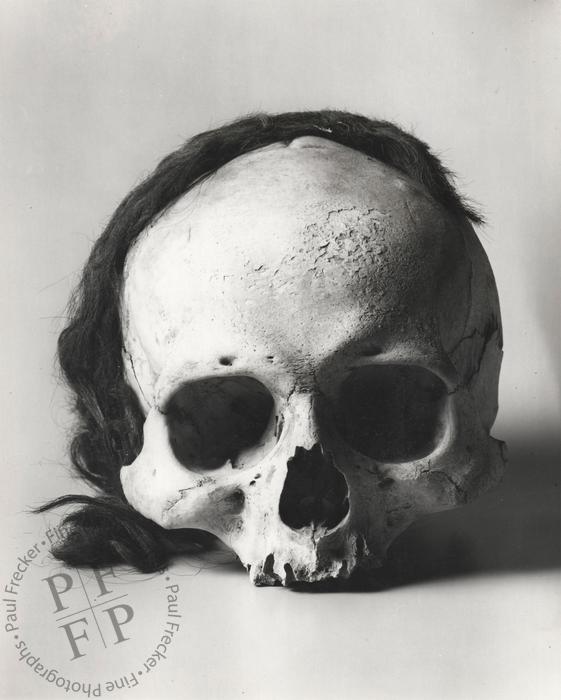
Costa Rican skull, c. 1970
Adrian Flowers of London
A black and white silver gelatin print showing a skull from Costa Rica in Central America.
Photographed by Adrian Flowers of London.
Born in Portsmouth in 1926, Adrian Flowers was educated at Sherbourne School in Dorset. He attended the British School of Photography before establishing a studio in London’s Dover Street in 1950. He later moved to Tite Street in Chelsea during ‘the Swinging Sixties.’ He was known for his portraits of celebrities and for his advertising work. During his career his assistants included Terence Donovan and Brian Duffy. He died at his home in southwest France on 18 May 2016.
See The Guardian (30 May 2016) for his obituary by Amanda Hopkinson.
Condition: apart from a few very small imperfections, the print is in excellent condition with very good tonal range.
Dimensions: not including a (slightly uneven) white border, the print measures 9.3” by 7. by 7.5” (23.6 cm by 19 cm).
code: cat035
